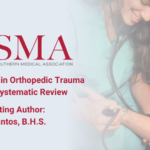Abstract | November 6, 2020
Biologic Options in Orthopedic Trauma Surgery: A Systematic Review
Learning Objectives
- The objective of this review study is to outline the advantages and disadvantages of various biologics used in orthopedic trauma surgery.
Background: The benefit of utilizing bone grafts has been well understood in the orthopedic community for decades. Bone grafting enhances bone repair, specifically in cases of bone loss or void. The classic source for autograft was the patient’s iliac crest and resulted in significant morbidity for the patient. Subsequent sterilization techniques and technology has provided surgeons promising allograft options. Furthermore, synthetic options have been introduced in an attempt to decrease the morbidity of autografts and decrease the transmission of disease during allograft procedures. When determining the graft of choice, parameters such as osteoconductivity, osteoinductivity, ostegenicity, graft price, morbidity and complications should all be considered.
Methods: A systematic literature review of PubMed and UpToDate databases was conducted. Articles published between 2010 and 2020 were retrieved, and the search was expanded by reviewing articles from reference sections of selected papers. A total of seventy-five articles were selected for the initial review. After examining those, a total of thirty studies met inclusion criteria.
Results: Of the three main categories of biologics (auto-, allo-, and synthetic grafts), autografts display the highest compatibility and highest array of desired properties within orthopedics, including optimal osteoconductivity, osteoinductivity, and osteogenicity. Autografts also include the least cost burden, but at a greater risk of morbidity to the patient. Allografts demonstrate slightly less osteoconductive properties, less potential osteoinductive properties, and no osteogenic potential. However, allografts spare the patient of donor site morbidity associated with autograft harvesting. Nevertheless, there is a large propensity for infection transmission and host rejection due to a lack of histocompatibility. Allograft costs vary widely yet stay relatively comparable to structural synthetics. Structural syntheticsprovide some osteoconductive and osteoinductive properties but pose greater risk of resorption.
Conclusion: Effective bone healing rests upon the judicious usage of bone grafts, bone substitutes, and synthetic factors. The determination is based on the ability to foster osteogenesis, osteoconduction, and osteoinduction while considering the associated costs and complications. Autograft remains the “gold standard” in regard to histocompatibility and osteointegration properties albeit posing donor site morbidity. To mediate these health risks, allografts and structural synthetics have been utilized. However, the reduced osteogenic and osteoinductive potentials in combination with the relative higher costs and risk of infectious transmissions and resorption has rendered them a case by case modality. The development of different bone graft modalities has nuanced the management possibilities available to surgeons and may spearhead rapid bone healing with increasing clinical effectiveness, safety, and narrower indications for maximized treatment success.

